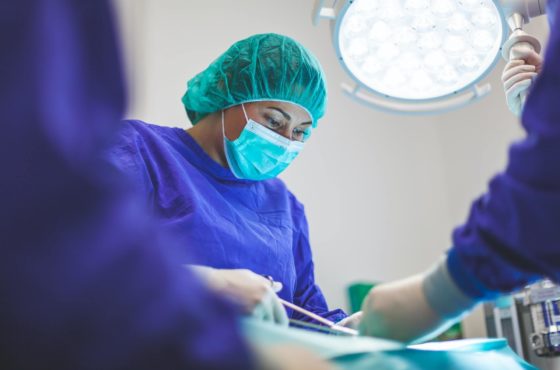Mesh migration is a kind of hernia mesh complication experienced by patients after a hernia repair using mesh.
This complication mostly happens when a defective hernia mesh is used for the procedure. Painful experience is an understatement to describe what victims of these defective medical devices that suffer from mesh migration go through.
To add to that, hernia mesh migration can also lead to other serious injuries and complications. Many plaintiffs who filed a hernia mesh lawsuit claim that mesh migration is just one of the many complications they have suffered due to an allegedly faulty hernia mesh implant.
Read on to learn more about hernia mesh migration and some of the damages that this can further cause.
What is Mesh Migration?
Mesh migration happens when a surgical mesh intended for hernia repair detaches and moves from the surgical site to a different part of the body.
The hernia mesh device can migrate, for instance, through the abdomen or any other nearby organs or tissues, which can cause more severe complications in hernia patients including adhesions, abscesses, fistula formation, bowel obstruction, and bowel perforation.
Cases of hernia mesh migration are underreported, so the exact numbers of patients who suffer from this complication is hard to ascertain. However, as of October 2020, 14,900 hernia mesh lawsuits were pending against mesh manufacturers including Ethicon, Atrium, and Bard Davol.
How Does Mesh Migration Occur?
Hernia mesh migration can happen due to one of two circumstances: primary or mechanical migration, or secondary migration.
How does the two differ?
Primary or mechanical migration occurs when mesh is not properly secured to surrounding tissue, causing it to fall out of place from the surgical site due to its inadequate placement.
However, even a securely placed hernia mesh medical device can also potentially move out of place if an external force causes it to separate from its intended spot. This type of migration generally happens within a short time following hernia repair surgery.
Secondary migration, on the other hand, is the result of an infection or the body’s inflammatory response to the hernia mesh implant which causes scar tissue to form. This inflammation slowly breaks down the mesh material, causing it to erode. Mesh erosion ultimately leads to shrinkage of the device and its migration.
This type of migration happens gradually or over a few months or years after mesh repair.
What Are the Symptoms of Mesh Migration?
Hernia patients who suffer from mesh migration may experience symptoms that are similar to hernia mesh failure symptoms, which include:
- fever and chills with an unknown cause
- bowel obstruction
- mild to severe pain
- nausea and vomiting
- the incision site is warm or hot to the touch
- fluid buildup at the surgical site (seroma)
- delayed healing of the surgical wound
- inability to pas gass or stool
- chronic pain
Talk to your doctor if you had hernia mesh repair in the past and you begin to notice or experience these symptoms.
Complications from Mesh Migration
The complications of hernia mesh migration may differ from person to person, mainly depending on the surgical site and the type of hernia mesh product used for the surgery. However, in general, mesh migration can cause:
- infection
- significant bleeding
- fistula formation
- hernia recurrence
- organ perforation
- chronic pain
The consequences of mesh migration can also depend on the organs involved in the movement of the device. For instance, mesh that has migrated into the urinary bladder can cause serious health problems including hematuria, which is the presence of red blood cells in urine, and recurrent urinary tract infections.
The mesh can also potentially migrate into the scrotum, which can lead to bowel obstruction, tenderness, organ strangulation, and organ perforation.
In the most severe cases of mesh migration, the mesh device may become unanchored and may wrinkle and fold up into a ball-like clump known as meshoma. Meshoma can rub against surrouding tissue and nerve fibers, which can lead to nerve damage and chronic pain. These injuries could require a patient to undergo long-term pain management programs.
Is Revision Surgery Necessary?
The short answer? Yes.
When migration or erosion occurs due to a defective hernia mesh product, the only way you can have the faulty medical device and the surrounding scar tissue removed is through a revision surgery.
Additional surgery may also be necessary in order to correct other complications caused by hernia mesh migration, such as bowel obstruction and hernia recurrence.
How is Mesh Migration Diagnosed?
It is difficult for a patient alone to determine if he or she is suffering from mesh migration. If you have hernia mesh migration symptoms which can be similar to signs of hernia mesh rejection, consult your doctor for medical advice immediately.
Your doctor should order the appropriate tests you should take for proper diagnosis. Diagnosis of mesh migration may be difficult and requires the use of medical imaging techniques like a CT scan or an X-ray.
Hernia Mesh Products Recalled
The first hernia mesh recall was issued in late 2005 by Davol Inc., a subsidiary of C.R. Bard.
And in 2014, the U.S. Food and Drug Administration also announced a number of additional hernia mesh recalls and started to warn patients and the public about the allegedly defective medical device.
The recalled products were pulled from the market because the devices have caused patients to suffer from serious injuries, side effects, complications, and they have also been associated with revision surgeries for hernia mesh.
Some of the companies targeted by the regulating agency for manufacturing faulty hernia meshes were C.R. Bard for the potential risk of the defective mesh ring breaking apart and causing bowel obstruction or perforations, Ethicon Inc. for its Ethicon physiomesh and the potential hazard of the mesh losing its laminate coating, and Atrium Medical Corporation for packaging errors.
Why is Hernia Mesh Still Used Despite of its Risks?
Before the mesh implant used for hernia surgery was introduced, surgeons simply sew the hole where the hernia protruded. This method, however, led to a 25% to 50% chances of hernias coming back.
Doctors started using the mesh medical device for hernia surgery because of the idea that it would lower the percentage of hernia recurrence in patients. It has also been widely considered by surgeons as a gold standard for hernia repair. However, it has been known that some meshes may not be necessary in repairing certain types of hernias.
Add to that the fact that the fast-track program which allowed the sales of thousands of faulty hernia mesh products ended up exposing the device’s risks despite some known benefits.
Is There an Alternative to Hernia Mesh?
In a nutshell, the answer is yes.
This alternative technique is known as the pure tissue or Shouldice method. The Shouldice Technique for inguinal hernia repair is a type of surgery that involves using a patient’s own tissue to repair the hernia and requires local anesthesia and a sedative.
No foreign products are introduced into the the patient’s body during the procedure. This eleminates the chances of mesh infection, adhesions, fistulas, or perforations, as one’s own tissues are rarely rejected.
However, despite the availability of alternative treatments, hernia mesh is still a popular go-to by surgeons when it comes to hernia repair. In fact, mehs is still used in around 90 percent of surgeries.
What You Can Do
No patient should have to go through another surgery in order to fix the problems caused by a defective medical device. Yet victims of defective mesh products often find themselves back at the hospital to have their surgeon repair the damages caused by the hernia mesh device.
Moreover, a patient who had to undergo surgery for hernia mesh removal often suffer not only from a number of hernia mesh injuries, but also from medical bills from the additional procedure which should not have happened in the first place.
If you or a loved one suffered from hernia mesh migration and other injuries or complications due to a defective mesh used following a hernia mesh surgery, it is important to know that you are not alone. Many victims of defective mesh have also experienced similar problems.
A number of these victims have made use of their legal rights by filing hernia mesh lawsuits. After all, being able to hold abusive manufacturers accountable for the harm they have caused to unsuspecting patients may ultimately prevent them from causing more damages to other people in the future.




